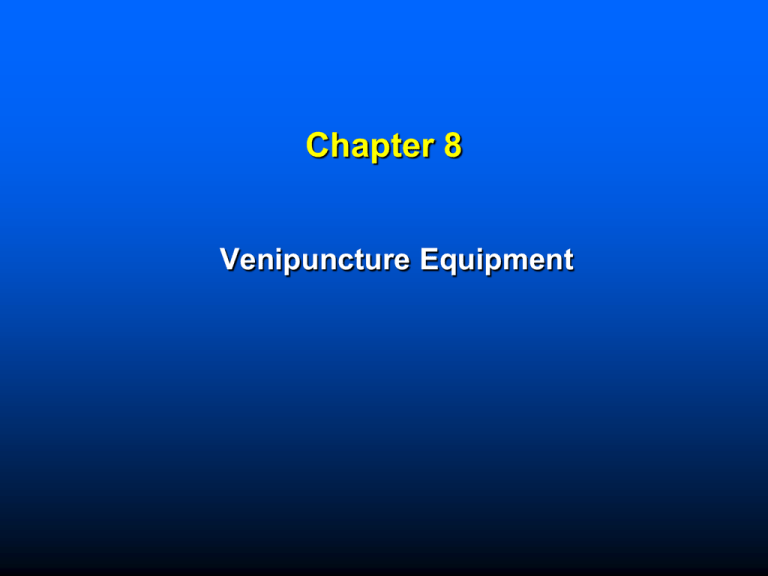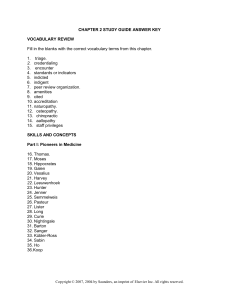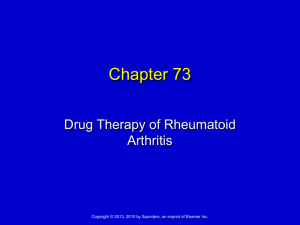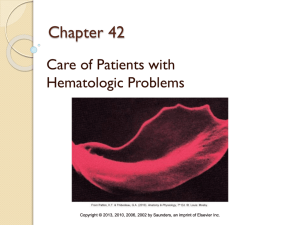
Chapter 8
Venipuncture Equipment
Learning Objectives
List the equipment that should be available
for venipuncture.
Describe the purpose of a tourniquet; list
types that may be used to locate a vein.
Differentiate between an antiseptic and a
disinfectant. List those that may be used for
blood collection.
Copyright © 2008 by Saunders, an imprint of Elsevier Inc. All rights reserved.
2
Learning Objectives
Locate the bevel, shaft, hub, and point of a
needle. Describe safety features that may be
included.
Define gauge.
Name the parts of a syringe, and describe
how the syringe system differs from the
evacuated tube system.
Copyright © 2008 by Saunders, an imprint of Elsevier Inc. All rights reserved.
3
Learning Objectives
Explain when a syringe system or winged
infusion set (butterfly) is used in blood
collection.
Describe the proper use of the tube holder
(needle adapter).
Differentiate whole blood, serum, and
plasma. List at least one use for each.
Describe at least nine additives, including
their mode of action and uses.
Copyright © 2008 by Saunders, an imprint of Elsevier Inc. All rights reserved.
4
Learning Objectives
List at least 10 different colors for tube
stoppers. Identify the additives(s) in each,
and state one use for each.
State the correct order in which various types
of tubes should be collected.
Describe the proper disposal of a used
needle.
Copyright © 2008 by Saunders, an imprint of Elsevier Inc. All rights reserved.
5
Phlebotomy Equipment
Equipment needed includes: needles, tubes,
sharps disposal container, needle holders,
syringes, winged infusion sets, pens, gloves,
tourniquets, antiseptic, gauze, and bandages.
Phlebotomists will carry equipment in a tray
or a cart to draw blood on inpatients. Never
place the tray on a patient’s bed.
Outpatients will come to a drawing station
and use a phlebotomy chair with a locking
armrest.
Copyright © 2008 by Saunders, an imprint of Elsevier Inc. All rights reserved.
6
Phlebotomy Equipment
Copyright © 2008 by Saunders, an imprint of Elsevier Inc. All rights reserved.
7
Tourniquet
A tourniquet is the most common way to
locate a vein.
A tourniquet prevents venous blood flow
which causes the veins to bulge.
A tourniquet may be latex or nonlatex.
A tourniquet may be used only once and
disposed of or cleaned before use on another
patient. Follow your facility’s policy regarding
tourniquet reuse.
Copyright © 2008 by Saunders, an imprint of Elsevier Inc. All rights reserved.
8
The Puncture Site
Use 70% isopropyl alcohol, an antiseptic, to
cleanse the skin before a venipuncture.
Alcohol left to dry on the arm is bacteriostatic.
Disinfectants are used on work surfaces to kill
microorganisms and are not safe for use on
the skin.
For allergic patients, use iodine, chlorhexidine
gluconate or benzalkonium chloride.
Apply a 2 in. by 2 in. gauze square to apply
pressure to the puncture site after needle
removal.
Copyright © 2008 by Saunders, an imprint of Elsevier Inc. All rights reserved.
9
Needles
All needles have a point, bevel, and shaft.
The shaft can differ in length and gauge.
The gauge describes the diameter or lumen
of the needle.
The larger the gauge number, the smaller the
lumen of the needle.
You will learn to pick the correct gauge
depending on the patient’s veins.
For adults use a 20 to 21 gauge; for children
or adults with small veins use a 22 to 23
gauge.
Copyright © 2008 by Saunders, an imprint of Elsevier Inc. All rights reserved.
10
Parts of a Needle
Copyright © 2008 by Saunders, an imprint of Elsevier Inc. All rights reserved.
11
Multisample Needles
This needle is doubleended with one tip used
on the patient’s arm and
the second end used to
pierce tube stopper.
There is a retractable
rubber sleeve that covers
the second tip when
tubes are changed to
prevent blood from
leaking into the holder.
Copyright © 2008 by Saunders, an imprint of Elsevier Inc. All rights reserved.
12
Syringes and Syringe Needles
A syringe has a plunger, a
barrel and a syringe needle
(Figure 8-4, p. 117).
Syringes are used on small,
fragile veins to control the
pull of vacuum on the veins.
Copyright © 2008 by Saunders, an imprint of Elsevier Inc. All rights reserved.
13
Syringes and Syringe Needles
You will see a flash of blood in the hub of the
needle when you are in the vein.
Blood must be transferred to evacuated
tubes.
Copyright © 2008 by Saunders, an imprint of Elsevier Inc. All rights reserved.
14
Winged Infusion Sets (Butterflies)
Butterflies are used on
pediatric or elderly patients
for small veins such as in
the hand.
The butterfly has a ½ to ¾
inch, 23 gauge needle with
wings and plastic tubing.
The syringe or tube holder
can be attached at the end.
From Bonewit-West K: Clinical Procedures for
Medical Assistants, 6th ed. Philadelphia,
Saunders, 2004.
Copyright © 2008 by Saunders, an imprint of Elsevier Inc. All rights reserved.
15
Needle Safety
OSHA and the Needle Safety and Prevention
Act requires the use of safety devices when
collecting and transferring blood.
There are many kinds of safety needles and
safety holders available for use.
Copyright © 2008 by Saunders, an imprint of Elsevier Inc. All rights reserved.
16
Evacuated Tube System (ETS)
The ETS uses a multisample needle, an
evacuated tube and an adapter.
The needle and holder are used once and
then disposed of “intact” into a sharps
container.
It is best to use tubes, holders, and needles
from the same manufacturer for best fit.
Copyright © 2008 by Saunders, an imprint of Elsevier Inc. All rights reserved.
17
Evacuated Tube System
Copyright © 2008 by Saunders, an imprint of Elsevier Inc. All rights reserved.
18
Evacuated Collection Tubes
Tubes are color coded and come in assorted
sizes in either plastic or glass.
The tube size selected depends on the
patient, his vein size and the amount of blood
needed.
Each tube contains an “additive” or chemical
added to the tube to prevent or promote
changes in the blood sample.
Copyright © 2008 by Saunders, an imprint of Elsevier Inc. All rights reserved.
19
Types of Blood Specimens
Whole blood is mixed with an anticoagulant to
prevent clotting and is for hematology cell
counts.
Serum is the fluid portion of blood after
clotting and is used for chemistry testing such
as glucose.
Plasma is the fluid portion of blood containing
an anticoagulant and is used for stat
chemistry testing.
Copyright © 2008 by Saunders, an imprint of Elsevier Inc. All rights reserved.
20
Tube Additives
Any tube with an additive must be inverted 5
to 8 times after collection.
Tube additives are identified by the stopper
color.
Many tubes are coated with silicone to
prevent blood from sticking to the sides.
Only the red glass tube contains NO
additives.
Copyright © 2008 by Saunders, an imprint of Elsevier Inc. All rights reserved.
21
Anticoagulants
Anticoagulants prevent blood from clotting.
The choice of anticoagulant varies with the
test being done.
Different anticoagulants work in different ways
to prevent clotting and yield plasma:
- EDTA, citrate and oxalate bind calcium.
- heparin inhibits conversion of prothrombin to
thrombin.
Copyright © 2008 by Saunders, an imprint of Elsevier Inc. All rights reserved.
22
Antiglycolytic Agents
Sodium fluoride is an additive in the gray
stopper tube used for glucose.
Sodium fluoride inhibits glycolysis, or
metabolism of glucose, for accurate testing.
Lithium iodoacetate is an acceptable
alternative also available in the gray stopper
tube for glucose testing.
Copyright © 2008 by Saunders, an imprint of Elsevier Inc. All rights reserved.
23
Clot Activators
Thrombin is an additive that promotes
coagulation.
Glass or silica promote clotting by providing
more surface area for platelet activation.
Tubes with clot activators must be inverted to
allow blood to come into contact with the
activator.
Copyright © 2008 by Saunders, an imprint of Elsevier Inc. All rights reserved.
24
Thixotropic Gel
An inert, synthetic substance with a density
between that of cells and plasma or serum.
When a blood tube with gel is centrifuged,
spun at high speed, the gel becomes liquid
and forms a layer upon hardening between
the cellular and liquid layer.
Example: SST (Serum Separation Tube)
Copyright © 2008 by Saunders, an imprint of Elsevier Inc. All rights reserved.
25
Color Coded Tube Stoppers
Tube:
Red (glass)
Allow 30 min. to clot.
Additive:
None
Specimen: Serum
Tests:
Chemistry (glucose)
Serology (rubella)
Blood Bank (group and Rh)
Copyright © 2008 by Saunders, an imprint of Elsevier Inc. All rights reserved.
26
Color Coded Tube Stoppers
Red (plastic)
Clot Activator
Serum
Chemistry (glucose)
Serology (rubella)
NOTE: Do not use for Blood Bank testing.
Tube:
Additive:
Specimen:
Tests:
Copyright © 2008 by Saunders, an imprint of Elsevier Inc. All rights reserved.
27
Color Coded Tube Stoppers
Light Blue
Sodium citrate (anticoagulant)
Plasma
Coagulation tests
PT (prothrombin time)
NOTE: Tube must be filled to its correct level to
maintain a 9:1 ratio of blood to anticoagulant.
Tube:
Additive:
Specimen:
Tests:
Copyright © 2008 by Saunders, an imprint of Elsevier Inc. All rights reserved.
28
Color Coded Tube Stoppers
Tube:
Additive:
Specimen:
Tests:
Lavender
K2 or K3 EDTA (anticoagulant)
Whole blood
CBC (complete blood count)
Hgb (hemoglobin)
Copyright © 2008 by Saunders, an imprint of Elsevier Inc. All rights reserved.
29
Color Coded Tube Stoppers
Tube:
Additive:
Specimen:
Tests:
Pearl
K2 EDTA plus gel
Plasma
Viral Loading
Copyright © 2008 by Saunders, an imprint of Elsevier Inc. All rights reserved.
30
Color Coded Tube Stoppers
Gold HemogardTM Closure
Red/Gray Stopper
Additive:
Clot activator/ thixotropic gel
Specimen: Serum
Tests:
Chemistry (glucose, BUN)
Both tubes referred to as SSTs for serum
separation tube.
Tube:
Copyright © 2008 by Saunders, an imprint of Elsevier Inc. All rights reserved.
31
Color Coded Tube Stoppers
Tube:
Additive:
Gray
sodium fluoride or iodoacetate to
preserve glucose; may be
combined with potassium oxalate
or heparin (anticoagulants).
Specimen: Serum or plasma
Tests:
Fasting blood sugar/alcohol levels
Copyright © 2008 by Saunders, an imprint of Elsevier Inc. All rights reserved.
32
Color Coded Tube Stoppers
Black
Sodium citrate (anticoagulant)
Whole blood
ESR (erythrocyte sedimentation
rate)
NOTE: Tube must be filled to its correct level to
maintain a 4:1 ratio of blood to anticoagulant.
Tube:
Additive:
Specimen:
Tests:
Copyright © 2008 by Saunders, an imprint of Elsevier Inc. All rights reserved.
33
Color Coded Tube Stoppers
Tube:
Additive:
Specimen:
Tests:
Green
Heparin (anticoagulant)
Plasma
Stat chemistry tests – glucose,
electrolytes, ammonia.
Copyright © 2008 by Saunders, an imprint of Elsevier Inc. All rights reserved.
34
Color Coded Tube Stoppers
Light green or green/gray stopper
Heparin/thixotropic gel
Plasma
Stat chemistry tests – glucose,
potassium, BUN.
This tube is referred to as a PST or plasma
separation tube.
Tube:
Additive:
Specimen:
Tests:
Copyright © 2008 by Saunders, an imprint of Elsevier Inc. All rights reserved.
35
Color Coded Tube Stoppers
Orange or yellow/gray stopper
Thrombin (clot activator)
serum
Chemistry tests when serum is
required on patients on
anticoagulant therapy.
This tube will clot the blood in 5 minutes.
Tube:
Additive:
Specimen:
Tests:
Copyright © 2008 by Saunders, an imprint of Elsevier Inc. All rights reserved.
36
Color Coded Tube Stoppers
Tube:
Royal blue
Additive:
Heparin/EDTA or none
Specimen: Plasma or serum
Tests:
Toxicology trace metals, lead
This tube is specially cleaned and has special
stoppers to prevent specimen contamination.
Copyright © 2008 by Saunders, an imprint of Elsevier Inc. All rights reserved.
37
Color Coded Tube Stoppers
Tube:
Tan
Additive:
Heparin
Specimen: Plasma
Tests:
Lead
Tube is formulated to contain less than
0.1microgram/mL (ppm) of lead.
Copyright © 2008 by Saunders, an imprint of Elsevier Inc. All rights reserved.
38
Color Coded Tube Stoppers
Tube:
Additive:
Yellow (Sterile)
SPS (sodium polyethanol
sulfonate) to inhibit complement
and phagocytosis and keep blood
from clotting.
Specimen: Whole blood
Tests:
Blood culture to recover
organisms that cause blood
infection.
Copyright © 2008 by Saunders, an imprint of Elsevier Inc. All rights reserved.
39
Color Coded Tube Stoppers
Tube:
Yellow (Nonsterile)
Additive:
ACD (acid citrate dextrose)
Specimen: Whole blood
Tests:
Paternity testing, tissue typing
The dextrose nourishes and preserves RBCs
and the citrate is an anticoagulant.
Copyright © 2008 by Saunders, an imprint of Elsevier Inc. All rights reserved.
40
Color Coded Tube Stoppers
Pink
K2 EDTA
Whole blood or plasma
Blood bank compatibility testing
and antibody screening.
This tube, similar to the lavender, meets
labeling standards for Blood Bank.
Tube:
Additive:
Specimen:
Tests:
Copyright © 2008 by Saunders, an imprint of Elsevier Inc. All rights reserved.
41
Order of Draw
1. Blood culture tubes- yellow sterile- to
prevent cross contamination from other
tubes.
2. Lt. Blue tubes for coagulation tests to
prevent contamination from other additives
that can interfere with testing.
3. Red, glass or plastic, gold, red-gray, SST
which, except for red-glass, contain clot
activators that could interfere with other
samples for testing.
Copyright © 2008 by Saunders, an imprint of Elsevier Inc. All rights reserved.
42
Order of Draw
4. Green or Lt. green tubes because the
heparin will not interfere with EDTA tubes.
5. Lavender tubes with EDTA which can affect
calcium and potassium levels if drawn
before other tubes.
6. Gray tube is last to avoid contamination of
tubes for electrolyte and enzyme testing.
All other colors are typically drawn after these.
Copyright © 2008 by Saunders, an imprint of Elsevier Inc. All rights reserved.
43
Needle Disposal
Activate the needle safety device immediately
after removing the needle from the arm.
Dispose of the needle and tube holder intact
into a closable, sealable, puncture resistant,
leakproof container clearly marked for
biohazard disposal.
Copyright © 2008 by Saunders, an imprint of Elsevier Inc. All rights reserved.
44








